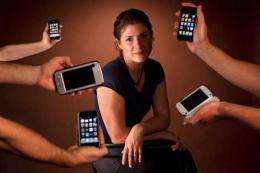Rethinking 'reachability'

(PhysOrg.com) -- In today’s world, the line between work and personal time often blurs. Communication technologies force people to negotiate when, where and how they are connected. While smartphones may increase on-the-job flexibility, they can also create unsustainable expectations of accessibility. This week, a UC Irvine team is launching a study to examine how busy professionals use and cope with wireless communication in their personal time.
Melissa Mazmanian, an informatics assistant professor at the Donald Bren School of Information & Computer Sciences; informatics doctoral student Ellie Harmon; and Christine Beckman, associate professor at the Paul Merage School of Business, will initially study two Orange County families and their relationships with their BlackBerrys, iPhones and similar devices. They expect to study 12 families over a two-year period.
“A lot of the conversations about new technologies focus on how to make them better and faster, but it’s equally important for us to think deeply about the implications of being connected all the time,” says Mazmanian.
“With smartphones, a person’s virtual or physical presence often is demanded by multiple individuals simultaneously. Someone may be home with family, participating in dinner conversation, but monitoring incoming emails. How are they actually dealing with competing demands for attention during their ‘free’ time?”
ICS Dean Hal Stern praised Mazmanian, saying, “Melissa's research reflects the Bren School's broad interests in technology. Her work helps us understand the impact of 'constant connectivity', and more importantly, demonstrates that it is possible to improve employee productivity and work/life balance.”
The new study builds upon Mazmainian’s prior research on a groundbreaking organizational change effort in an elite consulting firm. The goal: to institute predictable time off, so that each member of a project team could enjoy one evening a week away from work-related emails and phone calls.
While employees initially resisted, Mazmanian and Leslie Perlow of Harvard Business School found that successful teams learned to cover for each other during “off times,” strategized as a group about tasks, and engaged in dialogue that developed trust and psychological safety. Based on the results, the firm has instituted the changes internationally and is working to foster an environment that respects those who set boundaries.
“Certain individuals who participated found it to be truly life-altering,” Mazmanian says. “Only after being forced to disconnect were they able to realize the benefits. Our research emphasizes that this type of change effort is not trivial. It requires structural shifts in work practices, new communication conventions, and a willingness to buck the culture of individual heroics.”
Her doctoral research focused on the introduction and use of smartphones at a footwear manufacturing company. From 2005 to 2008, she followed two occupational groups — in-house attorneys and U.S. sales force — after they were given BlackBerrys by management.
The lawyers initially embraced the technology, but by the end of the study, almost all resented their BlackBerrys and “complained vociferously about increased expectations of off-hours availability and responsiveness,” Mazmanian recalls.
The sales team was at first resistant to the BlackBerrys but developed a sustained appreciation for the devices. Men and women, senior and junior, shared a similar story: The BlackBerry allowed them more personal time. Having the ability to check email on the road meant they didn’t come home to dozens of messages.
Although she has studied the implications of wireless communication for nearly a decade, Mazmanian didn’t own a smartphone until last year — when she realized the GPS feature could be extremely handy for a new Orange County resident. She bought one on the spot when she became hopelessly lost between two malls, and quickly found herself checking emails regularly.
“I’ve repeatedly found there’s no one right way to use wireless modes of communication,” Mazmanian says. “I’ve also discovered that part of the difficulty people experience with technologies of connectivity stem from avoiding tough but necessary conversations — learning how to disconnect without offending co-workers, family and friends.”
Provided by University of California, Irvine
















